Family : Anatidae

Text © Dr. Gianfranco Colombo

English translation by Mario Beltramini
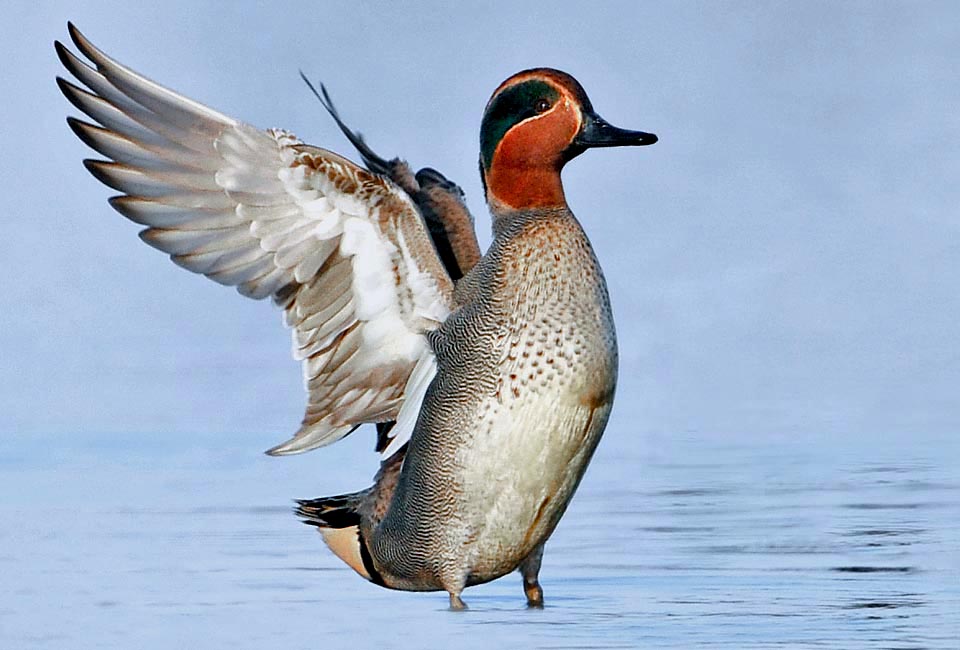
A duck wings? These, narrow and pointed are hawk wings! With a weight of 350 g and 70 cm of wingspan, Anas crecca is the smallest and the most agile palearctic duck © Gianfranco Colombo
The Common teal (Anas crecca Linnaeus 1758) belongs to the order of the Anseriformes and to the family of the Anatidae a very vast group that presently includes 152 species scattered in all continents. The references common to these two species are really so numerous even if they display, as we shall see later on, evident charateristics and behaviours quite different though linked between them. A first relation is related to the vulgar name given by the French to the two ducks that unites them both in the terms but differentiates them in the seasonal recurrence: sarcelle d’hiver for the common teal and sarcelle d’été the garganey. Same situation for the scientific name assigned by Linnaeus to the common teal. Anas crecca gets its origin for the genus, from the Latin term of the same name, “anas”, with meaning of duck whilst for the species the reference is the Swedish term “kricka”, name locally given to the common teal and probably of onomatopoeic origin but referred more to the garganey, whose typical cry is the rightly a continuous “crekcrek” of link and call.
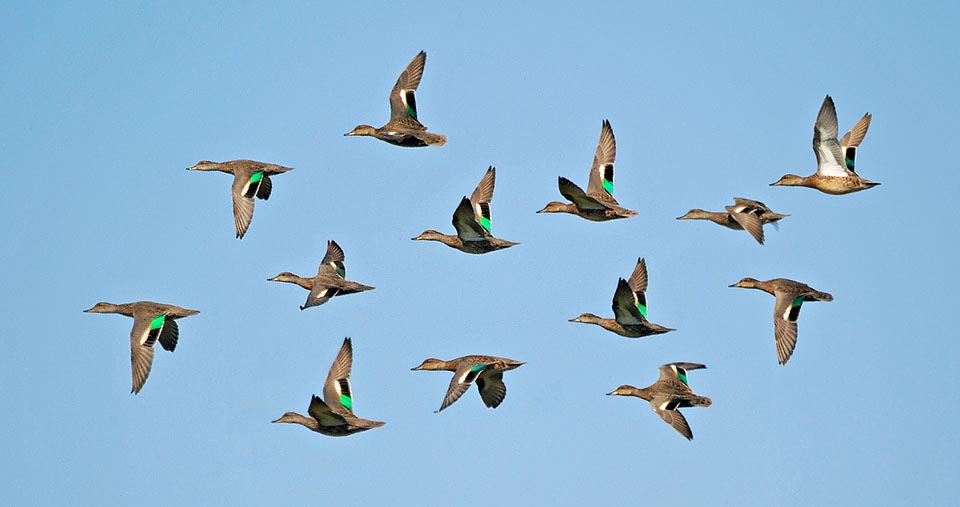
The nesting range is very vast. Covers almost all emerged lands above the 45° of latitude North, up to America, Asia and of Europe arctic coasts © Gianfranco Colombo
The characteristic morphology of the ducks, with a long neck, a stocky body, small and sharp wings with reduced lifting capacity and little developed remiges, requires the necessity of expressing a high cruise speed, in order to be able to stay in the air. The common teal defeats them all in this activity so much that it can carry out, when flying in compact flight with its conspecifics, aerial acrobatics like the waders, with sudden spins and turns, tonneaux and diabolical slides, unusual for a duck. Moreover, it can make the so-called burst, an extremely rapid take-off and perfectly vertical but at a speed unthinkable from a standstill, just like a sudden burst that bewilders the aggressor when done in group.
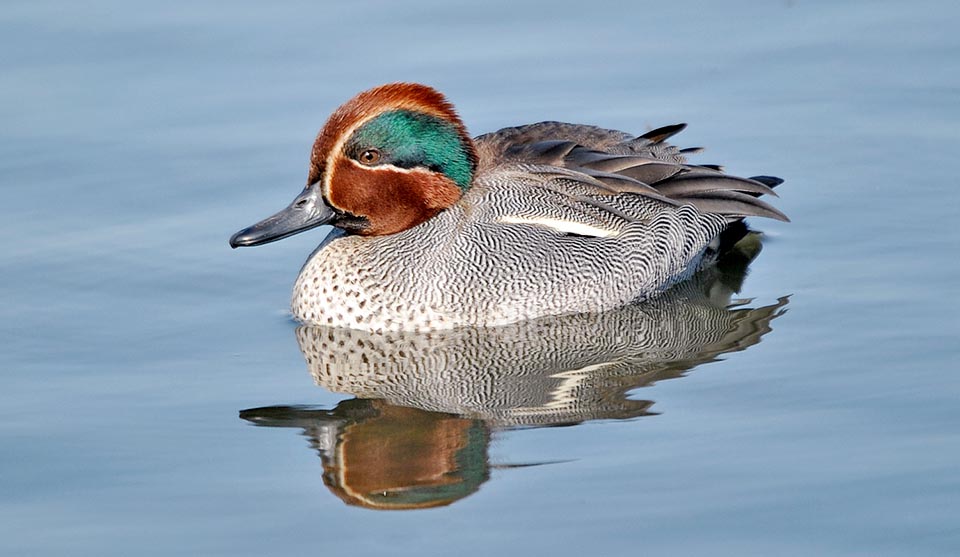
In the reproductive time the male is a real palette of colours. There is a marked sexual dimorphism that disappears almost completely in the eclipsal period © G. Colombo
So rapid is the take-off speed, so fast is ditching. Irresponsible dives that end practically splashing in the water with loud impacts. Here are some vulgar European names: in English Common Teal, in Italian Alzavola, in German Krickente, in Spanish Cerceta Común, in French Sarcelle d’hiver and in Portuguese Marrequinha-comum.
Zoogeography
The common teal has a very vast nesting range that practically covers all emerged lands above the 45° of latitude, and up the coasts of the Arctic Ocean, of America, of Asia and of Europe. It nests also in Iceland but is practically absent in Greenland even if in Canada it can be found present at the same latitude. Europe is the only continent not fully inhabited. As a matter of fact, besides being totally missing in the Mediterranean area, from the Iberian Peninsula, the Balkan one and Anatolia, is sporadic also in the central-western and oriental parts of the continent, with isolated populations not always constant. Also in Italy is present in reduced and standoffish number, with few couples relegated mainly in the Po Valley.
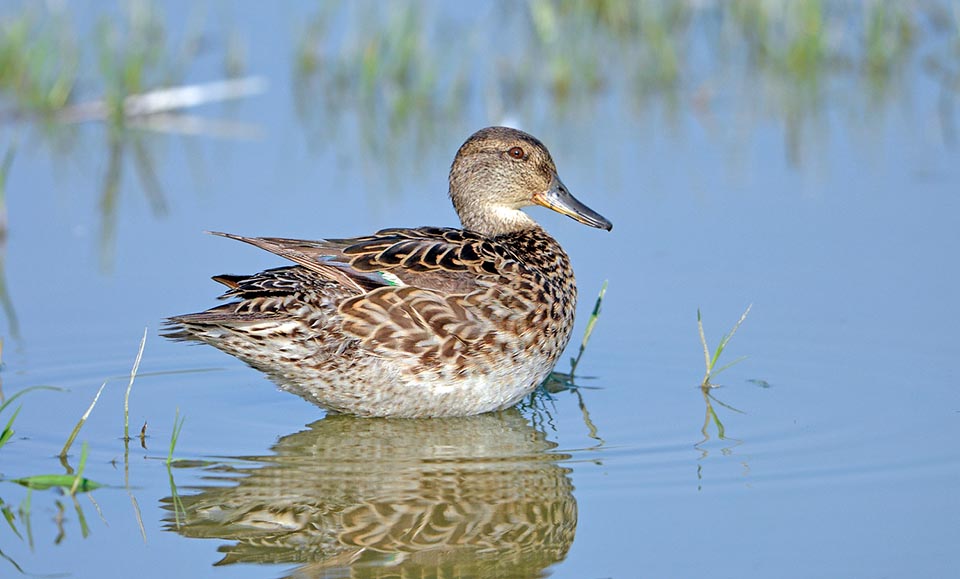
The female, in charge of brooding, instead needs a mimetic plumage to get unnoticed to the predators © Gianfranco Colombo
Ecology-Habitat
During the summer, in the nesting period, the common teal prefers still water surfaces even if small, placed inside thick but low vegetation, lagoons bordering important water streams, semi-flooded lands close to small lakes but also in humid plains well distant from the waterways but covered by thick grassy layer where to place the nest.
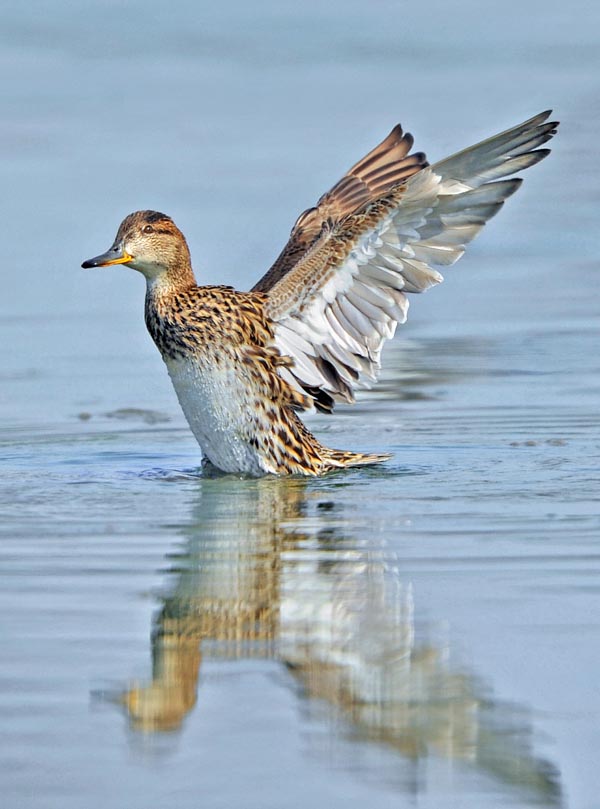
Faithful and assiduous mother, she choses the good place for the nest. It builds it piling up dry grasses and roots, makes it soft, tearing off own down, and then broods for almost 3 weeks © G. Colombo
During the winter its habitat widens to territories with more varied vegetation. First of all, in this period the common teals merge in very numerous groups so much to form flocks at times of thousands of specimens and together they love to frequent ampler and more open environments, water surfaces surrounded by reeds, coastal swamps, lagoons, small artificial lakes, estuaries, shallow lakes but also slow flowing rivers.
The common teal is a surface duck and finds the food immersing deeply the head waving the legs in the air but occasionally, as for fun, plunges for very short dives in few centimetres of depth but with very fast and noisy actions surely not good for getting food but instead for taking a bath or as for taking off some parasite from the body.
It is a rather reserved species and never takes advantage from habitats shared with the human beings or with human activities. On the contrary, even if being an elusive and reserved species, is one of the most common victims of the hunters of the whole world that during the shooting season get with them consistent game-bags.
Morpho-physiology
The Anas crecca is the smallest duck of the palearctic, measuring only 35 cm of length in the male and little less in the female, a weight of about 350 g and a wingspan of 70 cm. It has narrow and pointed wings so much to seem, when flying, a very fast limicolous.
The sexual dimorphism is remarkable having the sexes liveries absolutely different between them and not at all connected or imitated.
Surely, like in all the anatids, is valid the concept that the female having to brood in open air, needs a completely mimetic camouflaging and little visible from above while crouching on the nest. The plumage of the female is totally brown spotted of yellowish and similar to very many other females of anatids especially to the garganey that at times results indistinguishable excepting a slightly shorter bill marked by small orange streaks. The bright green speculum feathers almost always visible even with closed wings and does not have an evident whitish eyebrow like the garganey.
The bill is greenish grey but displays small orange smears at its base and along the border of both mandibles, one of the small marks that distinguish it from the similar garganey that, conversely, has it totally grey. On the contrary, the male, when in nuptial livery, displays a real palette of colours. The head is completely of vivid hazelnut colour, is wrapped by an ample emerald-green strip with bluish reflections that starting from the front of the eye goes down, widening, to join on the nape. As delimitation of the strip, in the lower subocular part, passes an extremely delicate yellow line that accompanies up to the cheeks this strip marking distinctly its limit.
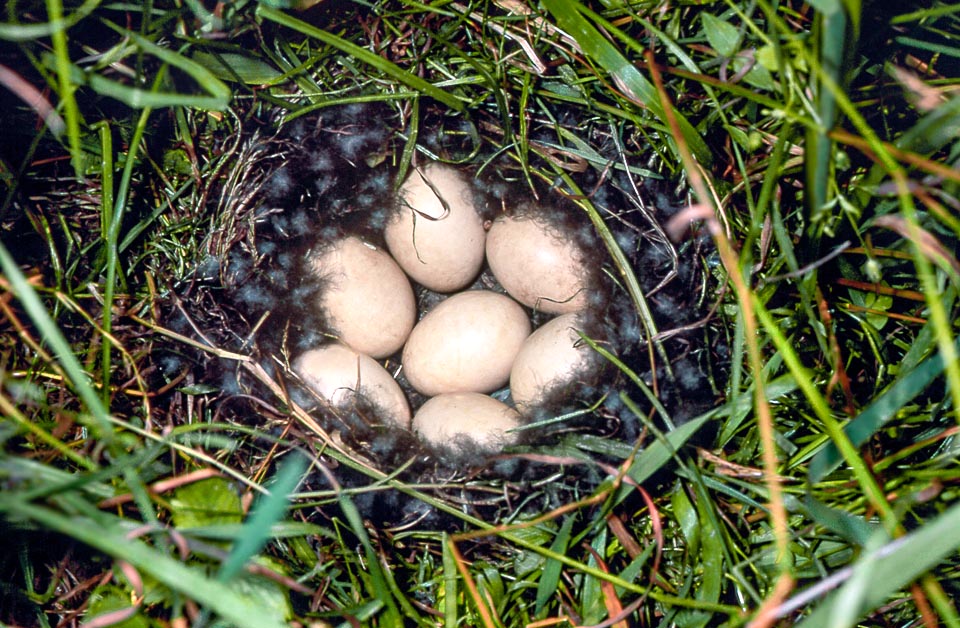
The nest, that contains 2-7 eggs, is on the ground, well hidden by the vegetation: only trace is the walkway created by the female in the grass when going out for feeding © Museo Civico di Lentate su Seveso
The speculum is of very bright green colour tending blue from some angles and little visible when staying on the ground but shining, when in flight, reflected by the sun light. When in the air, it displays a white underwing and on the alar cover besides the visible green speculum also a blackish one on its side and both surmounted by a thin, but very marked, white belt, in turn sided by others of brown colour that run parallel to the wing. The bill is tiny and rather short of blackish colour with a slight upward appearance whilst the legs are greenish. Reduced tail like most of the ducks and slightly pointed.
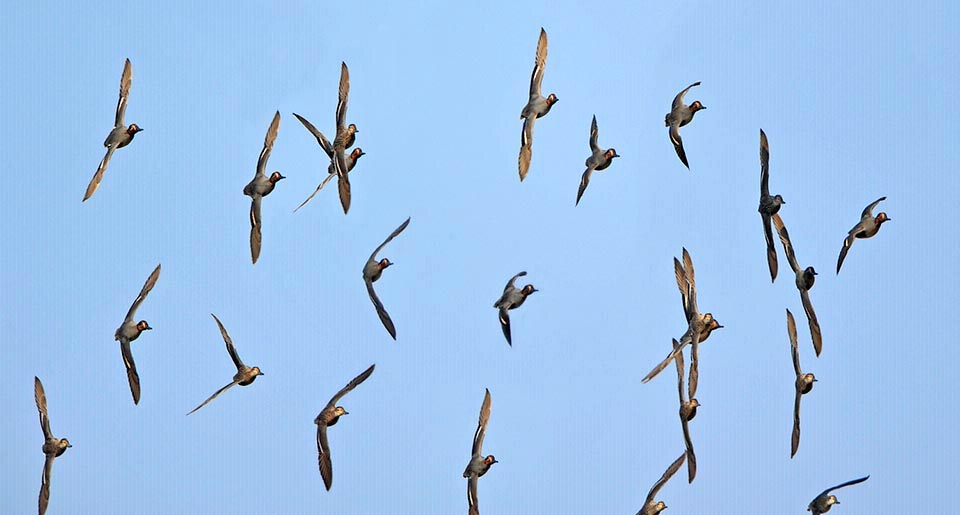
In case of danger the common teals get all in flight, vertically, with unthinkable speed from still and with the bursting noise that disconcerts the aggressor © G. Colombo
Ethology-Reproductive Biology
The common teal is a very faithful and assiduous mother. It is she who is interested in the choice of the place and to the construcrtion of the nest and always she who cares the brood. The nest is placed in dry part of the ground, hidden among the high grass, and covered by the dense grassy vegetation that hinders the view from above.
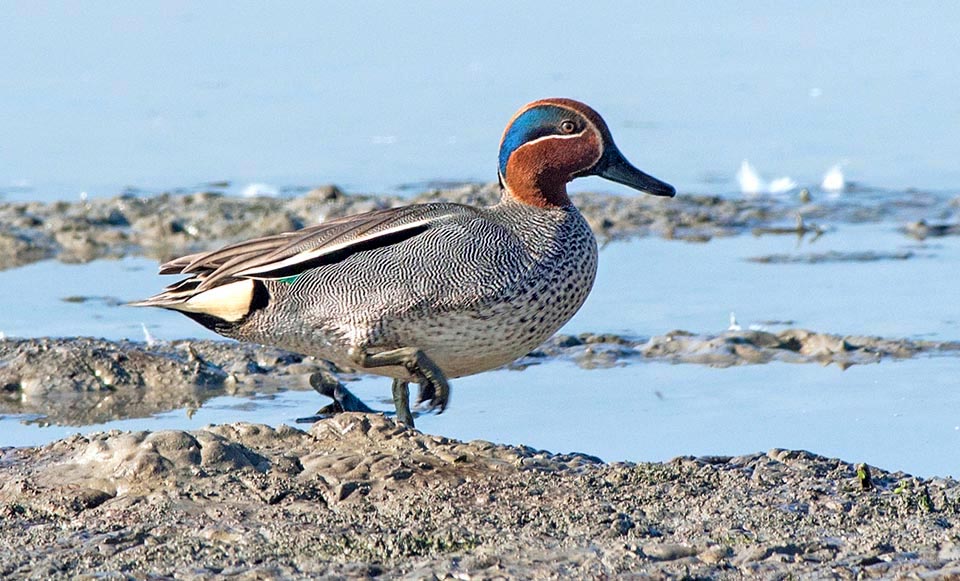
Very linked with water, they spend three quarters of the day, night included, nourishing of aquatic plants, insects, crustaceans, mollusks and grains with raids in fields © Gianfranco Colombo
The brooding lasts about 20 days during which the male keeps watchful thereabout but only for defending the territory and communicating eventual intrusions of predators. The nest may be even at some hundreds of metres from the closest water surface but it is not rare to find it directlty on the bank of the water stream. The walkway created by the female in the grass, when it leaves the nest for reaching the feeding place, is probably the only detectable trace of the presence of the nest of this elusive bird.
The hatching occurs almost at the same time for all the laid eggs and the ducklings are immediately capable to abandon the nest and to follow the mother, up to the nearest pond they will never abandon until they reach the dimensions of the adults and the complete autonomy in the flight. They will keep with the female for about 4-5 weeks even if they are at once able to feed autonomously and then to render themselves totally independent.
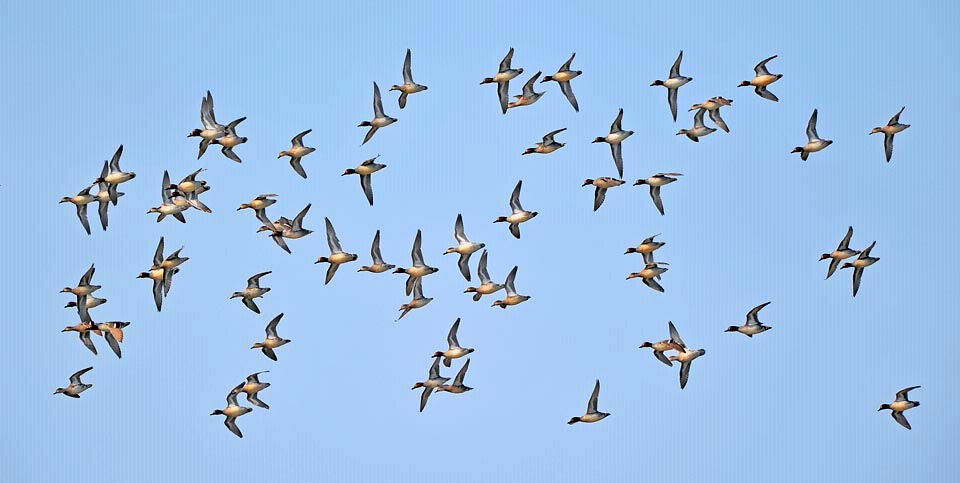
It is however an animal that avoids the man, more social in winter when it continuously emits, risking the shotguns, the typical link muttering © Gianfranco Colombo
This duck spends about three quarters of the day busy in looking for food and therefire must take advantage also of the twilight and night hours to satisfy its own feeding necessities. This greed can be reason the the remarkable energy that it expresses in its movements, always active and tireless. It is a very noisy species in any moment of the year and of the same day in particular by the male and in the social moments of gathering with the conspecifics, during which it emits continuously the typical and muttering “guit guit guit” of connection. Considering the enormous territory occupied and the adequacy of the single local populations, this species is not considered as endangered.
→ To appreciate the biodiversity within ANSERIFORMES please click here.
